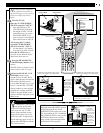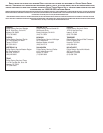
GLOSSARY TO TELEVISION TERMS
51
Aspect Ratio * The proportions of a rectangular display screen.
NTSC television has a 4:3 ratio; HDTV is 16:9.
Audio/Video Inputs * Located on the rear of the TV these
connectors (RCA phono type plug) are used for the input of audio
and video signals. Designed for use with VCRs (or other
accessories) in order to receive higher picture resolution and offer
sound connection options.
Coaxial Cable * A single solid antenna wire normally matched
with a metal plug (F-type) end connector that screws (or pushes)
directly onto a 75 Ohm input found on the Television or VCR.
Display * An on screen message or graphics that help the user
operate and adjust TV feature controls. See On Screen Displays
(OSD).
HDTV * High Definition Television which offers approximately
twice the vertical/horizontal resolution of NTSC video, and sound
quality approaching that of compact disc. (Usually taken to mean a
picture of 1920 x 1080 pixels in a 16:9 aspect ratio.)
Identify* Method by which a remote control searches and finds an
operating code for another product (such as a VCR or Cable
Converter). Once the code has been "identified" then the TV
remote can operate and send commands to the other product.
LED * Light Emitting Diode or indicator.
Menu * An on-screen listing of feature controls shown on the TV
screen that are made available for user adjustments.
Multichannel Television Sound (MTS) * The broadcast standard
that allows for stereo sound to be transmitted with the TV picture.
NTSC * National Television Standards Committee format devised
for TV broadcasting signals in the 1940s (525 lines; 30Hz.)
On Screen Displays (OSD) * Refers to the wording or messages
generated by the TV to help the user with specific feature controls
(color adjustment, programming, etc.).
Picture -In-Picture (PIP) * Term used when two pictures are
shown on the TV screen at the same time. The smaller PIP picture
is supplied by a VCR (or other tuner/video playback source). The
PIP picture can also be moved and swapped with the TV's main
screen picture.
Programming * The procedure of adding or deleting channel
numbers into the TV’s memory circuits. In this way the TV
“remembers’’ only the locally available or desired channel
numbers and skips over any unwanted channel numbers.
Remote Sensor Window * A window or opening found on the TV
control panel through which infrared remote control command
signals are received.
RGB * Red, Green, Blue color component inputs used for
connection purposes with personal computers (PCs) and other high
definition video devices.
RF * Radio Frequency or modulated signal design used as the
carrier for television broadcasts.
Second Audio Program (SAP) * Another or additional audio
channel provided for in the Multichannel Television Sound (MTS)
broadcast standard. A monaural soundtrack included within the
recorded or video signal (usually containing a second language
translation for the displayed programming.)
Status * Allows the user to quickly confirm what channel number
is currently being viewed. Status can also be used to clear the TV
of on-screen displays or information (rather than waiting for the
displays to “time out” or automatically disappear from the screen).
SVGA * Super Video Graphics Array
S-Video Input * Allows direct connection of high-resolution video
sources, such as a Super VHS videocassette recorder, Laser Disc
player, etc. Provides improved picture resolution, sharpness, and
clarity.
Twin Lead Wire * The more commonly used name for the two
strand 300 Ohm antenna wire used with many indoor and outdoor
antenna systems. In many cases this type of antenna wire requires
an additional adapter (or balun) in order to connect to the 75 Ohm
Input terminals designed into the more recent Televisions and
VCRs.
Variable Audio Output * An adjustable audio output which
allows for volume variations at the source.
VGA * Video Graphics Array


















